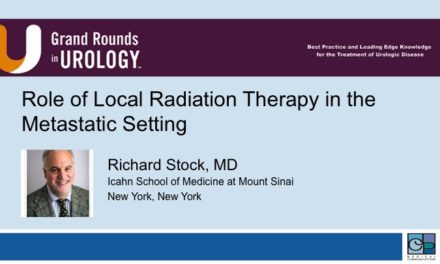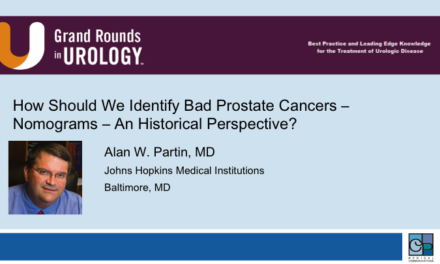Dr. Daniel P. Petrylak spoke at the 25th International Prostate Cancer Update on Saturday, January 24, 2015 on “Chemotherapy: The Past 25 and What to Expect in the Future.”
Keywords: chemotherapy, docetaxel, cabazitaxel, androgen, prednisone, lenalidomide, castrate resistant prostate cancer
How to cite: Petrylak, Daniel P. “Chemotherapy: The Past 25 and What to Expect in the Future” Grand Rounds in Urology. March 22, 2015. Accessed Apr 2024. https://dev.grandroundsinurology.com/prostate-cancer-daniel-p-petrylak-chemotherapy/.
Transcript
Chemotherapy: The Past 25 and What to Expect in the Future
It’s hard to believe as I said before this meeting is 25 years old. It’s been 10 years since the initial plenary presentations of docetaxel in castrate resistant prostate cancer.
We’re given at ASCO, this was in New Orleans in 2004. On the left is Mario Eisenberger who presented the data from the TAX 327 trial. I’m on the right and I presented the data from the SWOG 9916 trial. Dave Crawford was really instrumental in supporting us as chair of the Southwest Oncology group in moving out those trials forward.
In 2010 we really only had three different treatment regimens we can go forth with. Docetaxel gave about a three month survival benefit. Mitoxantrone and prednisone were the best supportive cares for chemotherapy.
Then after that with all these other newer agents, docetaxel still has about a three months survival but we have new cytotoxic agents such as cabazitaxel which are approved only in the second line. And of course the question is how do these agents interact with docetaxel along the chain of treatment?
These are the two seminal trials that got docetaxel approved by the FDA in 2004, TAX 327 which compared weekly docetaxel or every three docetaxel to mitoxantrone and prednisone. And then our study in SWOG 9916 combined estramustine with docetaxel and compared that to mitoxantrone and prednisone.
These studies showed about a 20% reduction in the risk of death and this is SWOG 9916. It’s a two month difference in the median.
And then TAX 327, this is the long term data after three years of follow-up. The three weekly regimen or every three week regimen demonstrated about a three month improvement in the median survival and a 21% reduction in the risk of death. You didn’t see that with the weekly, and then of course mitoxantrone was about 16 months. These data basically showed us that three year survival was possible in these patients, with 17% of men surviving three years and in the every three week arm 16% in the weekly and 12% in the mitoxantrone arm.
We basically dropped estramustine from this regimen because of the fact that it does engender significant cardiovascular toxicity, 15% in the docetaxel estramustine group, and we do see DVTs and other thrombolic events because of the estrogenic moiety.
Now 10 years ago, we started trying to combine docetaxel with every targeted agent that we knew of, and this included biological agents or metabolic agents such as vitamin D or DN101, GVAX, a vaccine, angiogenesis agents such as bevacizumab, VEGF-Trap, altrasentan, ZD4054 was a bone targeted agent, as well as dasatinib, lenalidomide is an angiogenesis agent, and the custersin is an antiapoptotic agent. All of these trials looking at combinations are negative and this is really unfortunate but I think there’s a lot to learn from these particular studies. To date, no combination improves docetaxel and prednisone survival over docetaxel and prednisone.
Let’s take a look at a couple of these studies to try to understand this a little bit better. This is a trial that just got accepted to Lancet Oncology, I’m the lead PI on it, looking at lenalidomide, the antiangiogenesis agent, very similar to thalidomide, combined with docetaxel and prednisone compared to docetaxel, prednisone alone. Very, very straight randomized phase 3 trial.
Unfortunately, there was no difference when you look at this as far as overall survival is concerned, and if you start looking at progression-free survival, there actually is about a one week poor progression-free survival combination. We’ve seen single agent activity with lenalidomide, and other drugs in the class such as thalidomide, why did this happen?
Well this happen I think because of the treatment exposure to docetaxel. Docetaxel is an effective agent and if you look at the experimental arm with lenalidomide, patients only receive six cycles of therapy. On the control arm, the median number of cycles was eight, and it also had a median higher dose intensity. You had more dose reductions in the lenalidomide, docetaxel arm versus the placebo, docetaxel arm. So perhaps the fact that we have less docetaxel administered was the reason for this particular issue.
As we see here there was much more toxicity in the combination, more neutropenia and more febrile neutropenia and this favored the control arm.
Now interestingly there was a higher rate of death in patients who discontinued lenalidomide and docetaxel, and this may be one of the problems of using antiangiogenesis therapy in prostate cancer. The fact is is that if you stop angiogenesis agents in kidney cancer, you can sometimes get a fast rebound in therapy or at least in tumor growth. So stopping lenalidomide may actually have accelerated these patients after they were taken off trial.
The ASCENT trial looked at vitamin D, an analog of vitamin D, DN101 combined with weekly docetaxel compared to docetaxel alone. This is the problem with doing subgroup analyses in these randomized phase 2 trials. If you look at an adjusted survival analysis, you see that the DN-101 combination weekly docetaxel arm was better than the weekly docetaxel arm. And this is looked at in terms of the multivariate Cox model where it was significant at a P value of 0.035.
Unfortunately when this was looked at in a larger randomized trial, docetaxel given every three weeks rather than weekly versus the docetaxel weekly calcitriol regimen, you found that there was no difference in survival. In fact, it was better in the every three week docetaxel arm. Again, this may be related to the overall dosage of docetaxel.
The final death analysis again showed a median survival of 19 months in the control for every three week docetaxel versus 17 months for the weekly arm.
Atrasentan, another drug that we evaluated in castrate resistant disease having a bone targeted activity. It’s an ETA receptor antagonist. As a single agent in castrate resistant prostate cancer we did tend to see a trend towards improvement in time to disease progression with a P value of 0.016. This was limited to those patients who had disease in bone. Again, improvements in worsening of pain score.
And this of course led us on in SWOG to a randomized trial of docetaxel atrasentan prednisone versus docetaxel and prednisone alone. I think you cannot superimpose two survival curves better than you see on this particular trial. Absolutely no difference in survival when you added atrasentan.
But is this the real reason, and this is the second hypothesis I have about the failures. Because if you start looking at subgroups of patients, and look at bone markers, so when we look at prognostic bone markers such as in this slide, NT peptide, and bone specific alkaline phosphatase, these will correlate in a final analysis of the atrasentan trial with response to atrasentan and docetaxel. Those patients who had the highest quartile of bone markers did the best with the combination, so we’re not selecting our patients properly. Inadequate doses of docetaxel not looking at biological markers, I think these would doom these particular randomized trials.
Then another issue about docetaxel which I think is important, does docetaxel act via the androgen receptor? We can find, if you look in cell lines that docetaxel will prevent translocation of the androgen receptor across the nucleus, so it effectively is an antiandrogen.
In fact, when we start looking at subgroup analyses from the abiraterone studies, we see that the waterfall plots from the PSA decline rates show a lower overall PSA decline rate with docetaxel after abiraterone. It’s only about 30%. And the survival is only about 13 months overall, so we may be seeing some interference from the previous use of the antiandrogen therapy. However, the one thing that’s missing from these trials is the fact that abiraterone was discontinued and I would argue that perhaps what you’re doing is releasing the portion of testosterone synthesis within these cells that may be actually feeding this progression or lack of activity.
Cabazitaxel also has been evaluated in castration resistant prostate cancer. This is a second line agent for this disease. It was taken from a variety of different drug screens. It’s more potent than docetaxel in vivo and in vitro tumor models and in fact what it is, it’s effective in those systems that have high levels of multidrug resistance which is an efflux protein that causes the cabazitaxel chemotherapeutic agents to be taken out of the cell. So it’s active in docetaxel resistant cell lines, and it certainly made sense to look at this in second line.
Oliver Sartor and Johann de Bono did a randomized phase 3 trial called TROPIC looking at cabazitaxel as a second line agent. What they found was, this was compared to mitoxantrone and prednisone, that there was about a three month difference in the median survival in those patients who received cabazitaxel and prednisone versus mitoxantrone and prednisone. Mitoxantrone was the control arm.
There are a number of questions that were raised by the cabazitaxel trials, because of neutropenia and diarrhea were optimal doses being used so that the FDA approved dose right now is 25 mg/m2 of cabazitaxel. The FIRSTANA trial is looking at cabazitaxel and comparing that to docetaxel first-line therapy and that is looking at two different doses of cabazitaxel to answer that question. PROSELICA has been run out of Johns Hopkins and that’s just simply a randomized phase 3 trial looking at again two doses of cabazitaxel in the second line setting to see if there’s a difference in toxicity and efficacy.
But also there are those who are trying to increase the efficacy of chemotherapy by using these antiapoptotic agents such as anticlustering and combining them with cytotoxic therapy. The AFFINITY trial just closed about six months ago. This is a trial that looked at custirsen which is an anticlustering antisense. It basically shuts down the RNA. And combining that with cabazitaxel and comparing that to cabazitaxel and prednisone. That trial is now pending and hopes that it will get a positive answer from that.
Now there’s been a lot talked here about early chemotherapy for castrate resistant disease, and I think one of the most important findings of this year was the presentation by Chris Sweeney at ASCO looking at administering docetaxel in those patients who are first going on hormone therapy. So this was a multicenter phase 3 trial that took 790 patients and randomized them within three months of starting androgen blockade to continue androgen blockade alone. Or six cycles of docetaxel without prednisone, every three weeks, for 18 weeks.
The primary endpoint was overall survival and these patients were divided into two different groups. The high volume patients were those patients who had more than four lesions on bone scan or who had liver metastases. And as we see from the left side, left Kaplan-Meier curve, the high volume patients had a difference in median survival of about 17 months. The hazard ratio was 0.6. This is the most significant hazard ratio we’ve seen to date in any cytotoxic trial for prostate cancer.
Now the low volume patients, they also had a trend towards a better survival, but the medians were not reached. Perhaps with further follow-up we’ll see the difference. The Europeans have done a study predominantly in low volume patients where they’ve seen a non-significant difference of about four months so I think patients need to be counseled about whether they should receive chemotherapy for low volume disease, but for the high volume patients in my opinion this is standard of care at this particular point.
This brings us back to some of the earlier trials I think that are worthy of mentioning. The SWOG 9921 trial looking at high risk patients post-prostatectomy giving them two years of blockade versus mitoxantrone for up to 12 cycles and then along with androgen blockage. This trial has not read out full yet but from what I understand there’s been no difference. Makes sense you’ve got ineffective chemotherapy.
But Mario Eisenberger attempted a trial like this which was a TAX3501 trial which looked at patients who high risk post-prostatectomy and randomized them to either observation androgen deprivation therapy or androgen deprivation therapy plus docetaxel.
There is an ongoing trial in the CALGB looking at this particular question. Moving chemotherapy earlier in high risk localized prostate cancer, giving neoadjuvant docetaxel prior to radical prostatectomy and randomizing patients to radical prostatectomy alone. I think this will be the ultimate answers to whether the ultimate early chemotherapy would work. But this trial of course has been accruing patients for a number of years and I think it’s going to be a while so it does read out.
So in conclusion, docetaxel and prednisone is still the standard of care for first-line chemotherapy for metastatic disease and should now be considered for high risk hormone sensitive patients. Further manipulation of docetaxel based chemotherapy is unlikely to provide therapeutic improvements. Cabazitaxel is FDA approved as second line chemotherapy.
And what we’ve learned from these trials in the past is that suboptimal doses and schedule of docetaxel may have been the cause of the lack of positivity in phase 3 trials. We’ve also assumed that castration resistant prostate cancer is one disease; that’s not so. We’ve also in the past used minimal single agent activity agents, predominantly agents that stabilized disease, and again I think we have to learn that lesson in the future. We have to better understand the resistance mechanisms and hopefully trials like the AFFINITY trial will help us to answer that question.
References
Cook RJ, Coleman R, Brown J, et al. Markers of bone metabolism and survival in men with hormone-refractory metastatic prostate cancer. Clin Cancer Res. 2006 Jun 1;12(11 Pt 1):3361-7.
http://www.ncbi.nlm.nih.gov/pubmed/8632312
Lipton A, Cook R, Saad F, et al. Normalization of bone markers is associated with improved survival in patients with bone metastases from solid tumors and elevated bone resorption receiving zoledronic acid. Cancer. 2008 Jul 1;113(1):193-201.
http://www.ncbi.nlm.nih.gov/pubmed/18459173
Mezynski J, Pezaro C, Bianchini D, et al. Antitumour activity of docetaxel following treatment with the CYP17A1 inhibitor abiraterone: clinical evidence for cross-resistance? Ann Oncol. 2012 Nov;23(11):2943-7.
http://www.ncbi.nlm.nih.gov/pubmed/22771826
Opgenorth TJ, Adler AL, Calzadilla SV, et al. Pharmacological characterization of A-127722: an orally active and highly potent ETA-selective receptor antagonist. J Pharmacol Exp Ther. 1996 Feb;276(2):473-81.
http://www.ncbi.nlm.nih.gov/pubmed/8632312
Petrylak DP, Tangen CM, Hussain MH, et al. Docetaxel and estramustine compared with mitoxantrone and prednisone for advanced refractory prostate cancer. N Engl J Med. 2004 Oct 7;351(15):1513-20.
http://www.ncbi.nlm.nih.gov/pubmed/15470213
Scher HI, Jia X, Chi K, et al. Randomized, open-label phase III trial of docetaxel plus high-dose calcitriol versus docetaxel plus prednisone for patients with castration-resistant prostate cancer. J Clin Oncol. 2011 Jun 1;29(16):2191-8.
http://www.ncbi.nlm.nih.gov/pubmed/21483004
Tannock IF, de Wit R, Berry WR, et al. Docetaxel plus prednisone or mitoxantrone plus prednisone for advanced prostate cancer. N Engl J Med. 2004 Oct 7;351(15):1502-12.
http://www.ncbi.nlm.nih.gov/pubmed/15470213
Verhaar MC, Grahn AY, Van Weerdt AW, et al. Pharmacokinetics and pharmacodynamic effects of ABT-627, an oral ETA selective endothelin antagonist, in humans. Br J Clin Pharmacol. 2000 Jun;49(6):562-73.
http://www.ncbi.nlm.nih.gov/pubmed/10848720
Zhu ML, Horbinski CM, Garzotto M, et al. Tubulin-targeting chemotherapy impairs androgen receptor activity in prostate cancer. Cancer Res. 2010 Oct 15;70(20):7992-8002.
http://www.ncbi.nlm.nih.gov/pubmed/20807808






